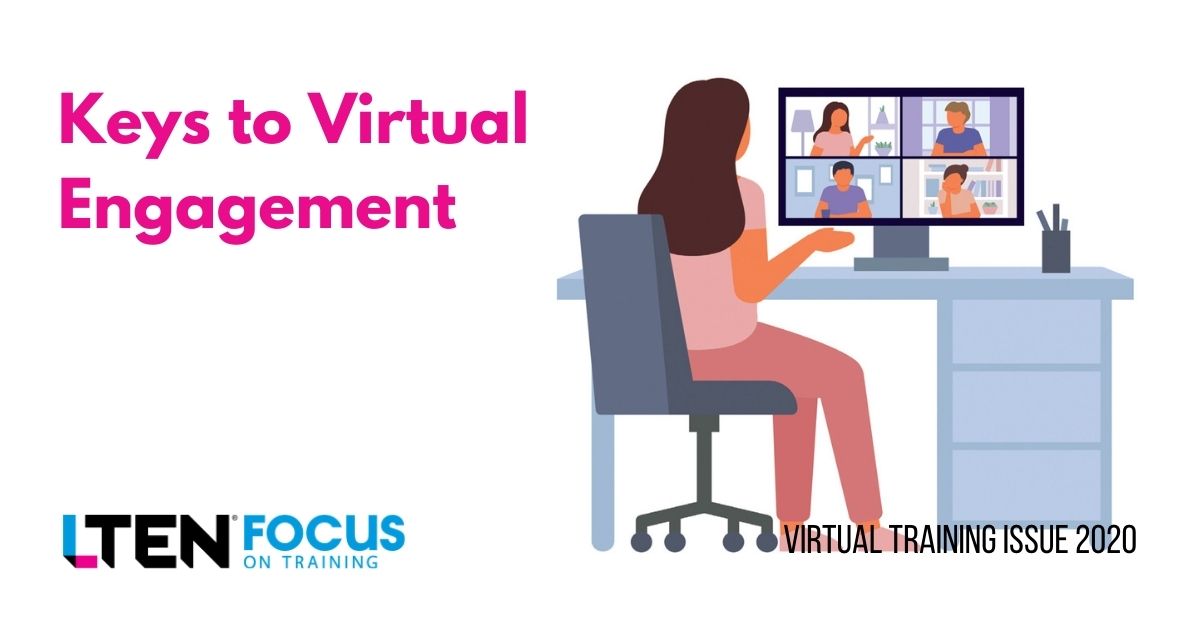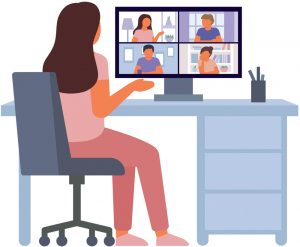
Keys to Virtual Engagement
FEATURE STORY – By Amy Glass
It is impossible to keep remote audiences engaged; the goal should be to reengage them continually.
 On March 6, 2020, I was driving to work listening to NPR and heard a great interview on the ways universities had responded to coronavirus. I was aware of the pandemic, but it hadn’t quite affected our lives yet in the United States.
On March 6, 2020, I was driving to work listening to NPR and heard a great interview on the ways universities had responded to coronavirus. I was aware of the pandemic, but it hadn’t quite affected our lives yet in the United States.
The reporter on Morning Edition interviewed Jeff Lehman, vice chancellor at NYU Shanghai, who said that although moving all their classes online had been very challenging, there had been one silver lining: “We have, as a faculty, been thinking more seriously about pedagogy in the last month than we have in the prior eight years.”
Months later, after experiencing the pandemic’s impact in the United States and delivering dozens of virtual training programs, I realize that this has been a silver lining. As trainers, we have had the chance to reflect and reexamine how we approach the art of teaching and engagement – and learn a few new tricks on the way.
Here are some lessons I have learned over the past months.
Master the Platform
One of the tricky parts of teaching online is becoming an expert on various virtual platforms. People use Zoom, Adobe, WebEx, Microsoft Teams and others, so trainers must improve our skills on all of them. Your organization may use more than one platform as well.
The key is to learn all the tools of the platform and the setting features. It is important to know that the polling feature works differently on Zoom than on WebEx, and that the breakout rooms have different capabilities on Adobe than Zoom. These platforms are regularly making updates, so setting up practice sessions and tech checks is essential for a seamless teaching experience.
Embrace Edutainment
We need to realize that it is impossible to keep remote audiences engaged; the goal should be to reengage them continually. Every three to five minutes we should use strategies — both low-tech and high-tech — to reengage learners.
- Low-tech tools: Stories, analogies, examples, case studies, asking questions to the group, asking questions to an individual (use their name and then repeat or paraphrase the question), making it conversational.
- Higher-tech tools: Two-way audio, text chat, whiteboards, polling, stamps and drawing tools, breakout rooms, videos and more.
Using these tools and strategies will enable you to continually engage learners in a variety of ways.
Chunk It Out
Pre-COVID, training was typically linked to an event – a conference or meeting. In these situations, the timing was often very tight. Now, since all meetings and training sessions are remote, we have the luxury of flexible timing and you should embrace it.
 We know that people cannot learn synchronously for eight hours at a time, so when we approach a one-day training, we need to rethink our plan. For example, consider two hours of learning in the morning (with a break) and then 90 minutes of role play or coaching in the afternoon. This schedule can then be repeated on the second day or over three days. You can even spread the sessions across multiple weeks with practice and field work in between. This approach maximizes people’s attention spans and engages them with the content over a longer period, leading to better retention and application.
We know that people cannot learn synchronously for eight hours at a time, so when we approach a one-day training, we need to rethink our plan. For example, consider two hours of learning in the morning (with a break) and then 90 minutes of role play or coaching in the afternoon. This schedule can then be repeated on the second day or over three days. You can even spread the sessions across multiple weeks with practice and field work in between. This approach maximizes people’s attention spans and engages them with the content over a longer period, leading to better retention and application.
Blank It Out
One trick when delivering content in person is to strategically blank the screen. This strategy helps the learners focus more closely on what is being said – or on each other for an exercise – without being distracted by what’s on the screen. Then, when you turn the screen back on, they are ready for new content. It’s easy to do this by just using the B key to “black out” the slide and pressing B again to bring the slide back.
Unfortunately, this favorite training trick doesn’t work when presenting remotely.
Here’s another trick from a trainer named Oliver in Germany:
To get the same effect, temporarily stop sharing slide deck. The view will then change so that participants are only looking at you and each other. This approximates the dynamic you can create at an in-person workshop: blanking out the screen, maybe sitting on the edge of the front table, telling a story or facilitating a discussion with the participants. You can also add an activity with one or more people doing something on-camera, moving the experience further in the direction of an in-person classroom. It makes the experience more like really being together.
It Takes Two … Or Three
When presenting in person, it’s often just the trainer delivering the content to the
audience. Same with teams. You collaborate on the design of the program and on the logistics, but you’re often out there on your own when delivering the training.
Virtual training has changed all of that! You can have more than one facilitator and always have a producer involved. Different people, voices and perspectives allow for more engagement – and the producer ensures that all the technology runs seamlessly.
Most professional speakers will not deliver content virtually without a producer. Two facilitators can act as each other’s producers where one facilitates and the other helps troubleshoot any technology hiccups and monitors the chat. Then they can switch roles. It’s highly encouraged to practice as a team to ensure the delivery, timing and technology run smoothly.
Lights … Camera … Action
Before moving training programs to virtual platforms, give some thought to lighting, background and how we look on camera. Since so much of learning is visual – and our learners only experience us through our webcam – here’s how to look better on camera:
- Position Your Web Camera: The goal is to be at eye level. This is when you are looking directly into the camera, as if you were talking to someone who was the same height as you. Laptops make this difficult since they sit lower. An easy fix is to lower your chair or purchase a moveable desk or put some books under your laptop to raise it. Once you are eye level, you want to frame yourself in the camera view, showing your head and shoulders. You should sit about one arm length away from your computer. Try making a fist and putting it on top of your head. If you can see the entire fist in the frame and it is close to the very top of the frame, you have good headroom.
- Lighting is important because it lets your audience see your facial expressions. Humans look best with full, face-on lighting! If you have a large window that lets in good natural light, position yourself in front of the window and facing it. Putting your back (and thus the camera) toward the window will give you the “witness protection look.” You can find an artificial light source through online shopping – search for “ring light” or “selfie light,” which is what all the TikTokkers use. These are also great for rooms where you have a strong light source on one side and need to balance it, or when you don’t have good natural light available.
- Dress & Makeup: Many web cameras are not high-quality, and have difficulty focusing on busy or small patterns. Solid-color clothes that do not match your background are best. And a little bit of translucent powder goes a long way … men included. If you are using a light, it increases natural shine. Powder knocks that out.
- Background: Like dress, we are aiming for benign. We want to minimize anything that could distract our audience and take away from our message and its impact. It’s fine to have shelving or wall hangings behind you, but stay away from personal items that reflect your religious or political beliefs. If you wouldn’t put it on your physical desk at an office, keep it out of your web camera shot. Virtual backgrounds should only be used if they are accepted within your company culture. Even then, aim for a professional background. If there are virtual waves crashing on a beach behind you, your audience will begin daydreaming about the beach and you’ve lost their attention!
Conclusion
There are a lot of things we can’t control right now. What we can control is creating the best learning experience for our participants and developing our skills as master facilitators.
Amy Glass is owner & CEO of BRODY Professional Development. Email Amy at aglass@brodypro.com.
Fall 2020 – Virtual Training








